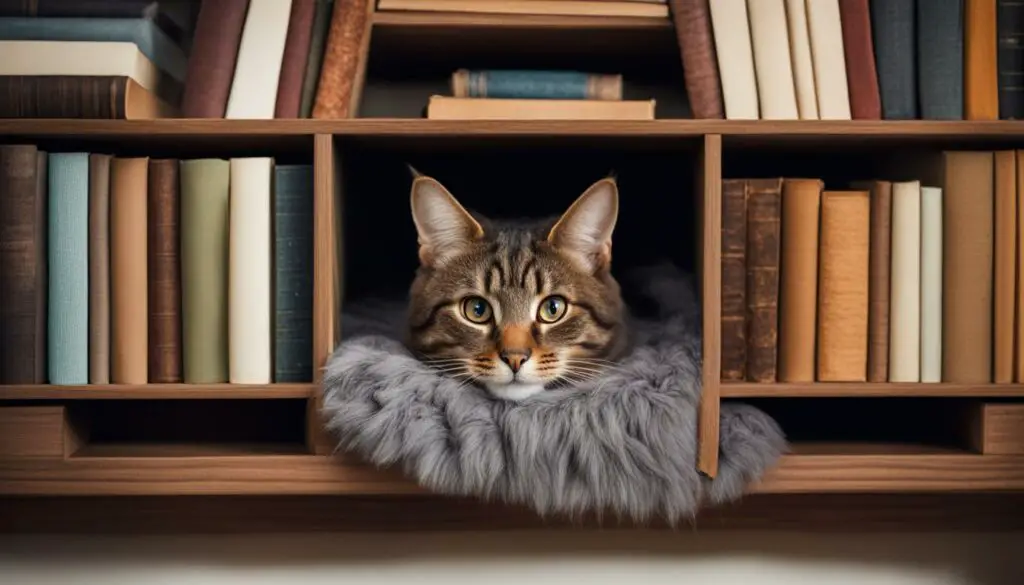As a cat owner, I understand the importance of providing a cozy and comfortable hiding spot for our feline companions. Cats are known for their love of finding the perfect hidey hole where they can retreat, relax, and feel safe. In this article, I will explore the various options available to create the best cat hidey holes for your beloved pet.
Creating a safe space for your cat is essential to their overall well-being. A hidey hole provides them with a sense of security and helps reduce stress. Whether it’s a cat tree, a cozy bed, or a DIY hiding spot, there are plenty of options to choose from. Let’s dive in and discover the best cat hidey holes for your feline friends.
Key Takeaways:
- Providing a cat hidey hole is important for their comfort and security.
- Cats prefer cozy and enclosed hiding spots.
- Consider options like cat trees, cat beds, and DIY hiding places.
- Ensure each cat has its own safe space in a multi-cat household.
- Avoid unsafe hiding places and make them inaccessible.
The Importance of Safe Spaces for Cats
Cats are known for their independent and curious nature, but they also require a sense of security in their environment. Providing them with safe spaces, such as hidey holes or hiding spots, is essential for their overall well-being. These safe spaces allow cats to feel comfortable, reduce stress, and avoid confrontations when they are feeling overwhelmed or anxious. By understanding the importance of safe spaces for cats, we can create a feline-friendly environment that promotes their physical and mental health.
Cats are sensitive creatures who thrive in an environment that offers them a safe retreat. Safe spaces provide cats with a place where they can feel secure and in control. This is especially important in multi-cat households, where each cat should have their own independent hidey hole to escape to. By having their own safe space, cats can avoid territorial disputes and establish a sense of ownership over their personal territory.
When cats feel stressed or anxious, they often seek out a quiet and secluded place to hide. By providing them with dedicated hiding spots, we can help alleviate their stress and promote a sense of calm. These hidey holes can be as simple as a cozy cat bed or as elaborate as a multi-leveled cat tree with enclosed spaces. The key is to offer a variety of options that cater to different cat personalities and preferences.
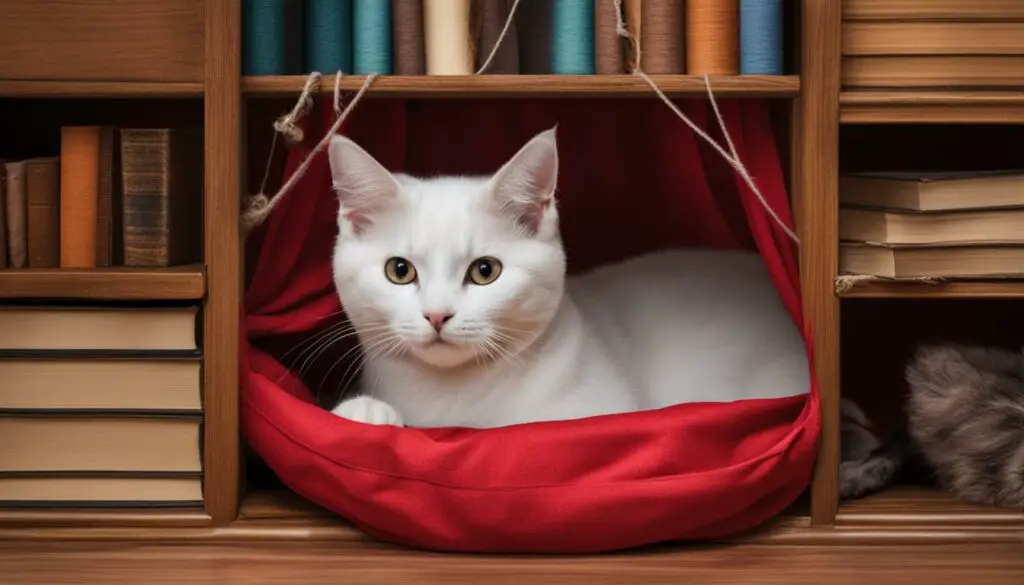
Creating a Safe and Secure Environment for Cats
When designing safe spaces for your cats, there are a few key considerations to keep in mind. First, choose hiding spots that are appropriately sized for your cats. They should be able to comfortably fit inside without feeling cramped or confined. Additionally, ensure that the hiding spots are located in quiet and low-traffic areas of your home, away from loud noises or sudden movements that can startle or stress your cats.
Incorporating features that mimic a cat’s natural environment can also enhance the effectiveness of safe spaces. For example, cat trees with scratching posts not only serve as hiding spots but also provide an outlet for a cat’s natural scratching behavior. Elevated hiding spots, such as shelves or perches, allow cats to observe their surroundings from a higher vantage point, fulfilling their instinctual need for vertical territory.
Choosing the Right Size and Enclosed Hidey Holes
When it comes to providing a safe and comfortable space for your cats to hide and relax, choosing the right size and enclosed hiding spot is crucial. Cats prefer hiding places that are tailored to their size, offering a sense of security and privacy. This is especially important in a multi-cat household, where each cat should have their own independent safe space to retreat to.
By opting for a hidey hole that is appropriately sized for your cat, you are giving them a cozy spot where they can feel protected and at ease. Consider their body size and weight when selecting a hidey hole, ensuring that they can comfortably curl up inside without feeling cramped. Enclosed hiding spots, such as covered cat beds or enclosed cat caves, are also preferred by cats as they mimic the feeling of a secure den.
In a multi-cat home, it’s essential to provide each cat with their own hiding place. This not only prevents conflicts or competition for resources but also gives each cat a designated space where they can feel in control. Cats are territorial animals, and having their own safe space can help reduce stress and promote harmonious coexistence among multiple feline companions.
Benefits of Choosing the Right Size and Enclosed Hidey Holes:
- Enhanced sense of security and privacy for your cats.
- Reduced stress and anxiety levels.
- Prevention of conflicts in multi-cat households.
- Promotion of harmonious coexistence among feline companions.
Remember, cats are individuals with different preferences, so it may take some trial and error to find the perfect hidey hole that suits your cat’s needs. Observe their behavior and pay attention to their comfort and enjoyment in their chosen hiding spot. By providing the right size and enclosed hidey hole, you are creating a safe and comforting space that contributes to their overall well-being.
| Benefits of Choosing the Right Size and Enclosed Hidey Holes: |
|---|
| Enhanced sense of security and privacy for your cats. |
| Reduced stress and anxiety levels. |
| Prevention of conflicts in multi-cat households. |
| Promotion of harmonious coexistence among feline companions. |
The Benefits of Cat Trees
When it comes to providing a cat with a cozy hidey hole, a cat tree is an excellent option. Cat trees not only offer hiding spots for your feline friend but also provide several other benefits that contribute to their overall well-being.
One of the main advantages of cat trees is that they often come with scratching posts. Cats have a natural instinct to scratch, and providing them with an appropriate outlet for this behavior can help protect your furniture. The height of cat trees also allows cats to stretch their bodies fully while scratching, which provides a satisfying experience for them.
“Cat trees not only offer hiding spots for your feline friend but also provide several other benefits that contribute to their overall well-being.”
In addition to scratching posts, cat trees also offer height and observation points. Cats are naturally curious creatures, and being able to climb to higher vantage points allows them to survey their surroundings safely. This helps fulfill their instinctual need for vertical space and can also alleviate boredom and anxiety.
Furthermore, many cat trees come with enclosed spaces or platforms that serve as cozy hiding spots. Cats often seek out small, enclosed spaces to feel secure, and having access to these areas can help reduce their stress levels. Whether your cat wants to nap peacefully or simply have a moment of solitude, the hidey holes provided by cat trees offer the perfect retreat.
| Benefits of Cat Trees | Explanation |
|---|---|
| Scratching posts | Aids in protecting furniture and satisfies cats’ natural scratching instinct. |
| Height and observation points | Allows cats to fulfill their need for vertical space, observe their surroundings, and alleviate boredom and anxiety. |
| Cozy hiding spots | Provides secure and enclosed spaces for cats to feel safe, reducing their stress levels. |
When choosing a cat tree, consider the size and preferences of your cat. Look for sturdy construction, comfortable materials, and a design that suits your home. With the right cat tree, you can provide your feline friend with a safe and enjoyable hidey hole that meets their natural instincts and enriches their environment.
Cozy Options for Cat Beds, Cat Caves, and Cat Hammocks
I believe providing cozy options for cats to relax and hide is essential for their well-being. Cat beds, cat caves, and cat hammocks are the perfect hidey holes that offer both comfort and security. These cozy options not only provide cats with a place to curl up but also serve as bolt holes for them to retreat when they need some alone time.
When it comes to cat beds, there are various styles to choose from. You can opt for a traditional round bed with plush padding or go for a more modern design like a doughnut-shaped bed. The key is to select a bed that is the right size for your cat, ensuring they have enough space to stretch out and feel cozy.
Cat caves are another popular choice for cats seeking a hiding spot. These enclosed structures offer a sense of privacy and security. They mimic the cozy den-like spaces that cats naturally seek out in the wild. Cat caves come in different shapes and materials, such as felt or plush fabric, and can add a stylish touch to your home while providing a comfortable hideaway for your feline friend.
| Cozy Options for Cat Beds, Cat Caves, and Cat Hammocks | Features |
|---|---|
| Cat Beds | – Plush padding – Various sizes and shapes available – Provides a comfortable space to stretch out |
| Cat Caves | – Enclosed structure – Offers privacy and security – Mimics natural den-like spaces |
| Cat Hammocks | – Suspended design – Provides a cozy spot to relax and observe surroundings – Can be attached to furniture or window sills |
Cat hammocks are another fantastic option for cats who love to lounge and observe their surroundings. These suspended beds provide a cozy spot for your cat to relax while keeping an eye on their environment. Cat hammocks can be attached to furniture or window sills, offering a unique and comfortable hideout for your furry companion.
Remember, each cat has its own unique preferences when it comes to hiding spots. Some may prefer the snugness of a cave, while others may enjoy the elevated perch of a hammock. It’s important to observe your cat’s behavior and provide them with options that suit their individual needs. With cozy hidey holes like cat beds, cat caves, and cat hammocks, you can ensure your feline friend feels safe, secure, and comfortable in their home.
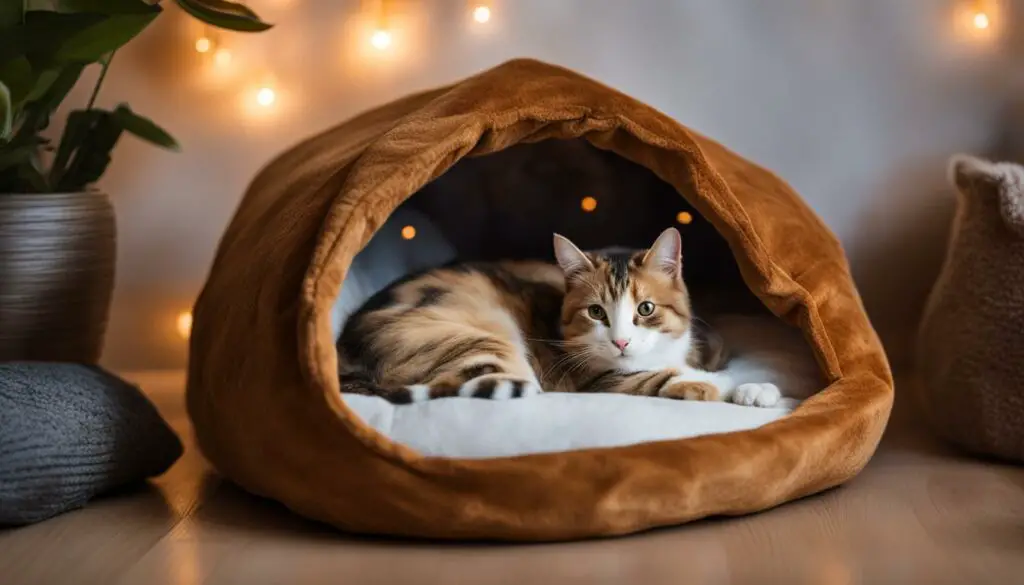
The Fun of Cat Tunnels
Cat tunnels are not just hiding places for our feline friends; they also provide hours of entertainment and play. Cats are naturally curious and love to explore nooks and crannies, making cat tunnels the perfect addition to their playtime repertoire. Whether it’s running through the tunnel, hiding inside, or pouncing on unsuspecting toys, cat tunnels offer endless opportunities for fun and exercise.
One of the reasons cats enjoy cat tunnels so much is that they mimic their natural hunting instincts. The enclosed space of the tunnel creates a sense of security and privacy, allowing cats to pounce and stalk their toys or imaginary prey. This type of interactive play helps keep cats mentally stimulated and physically active, which is important for their overall health and well-being.
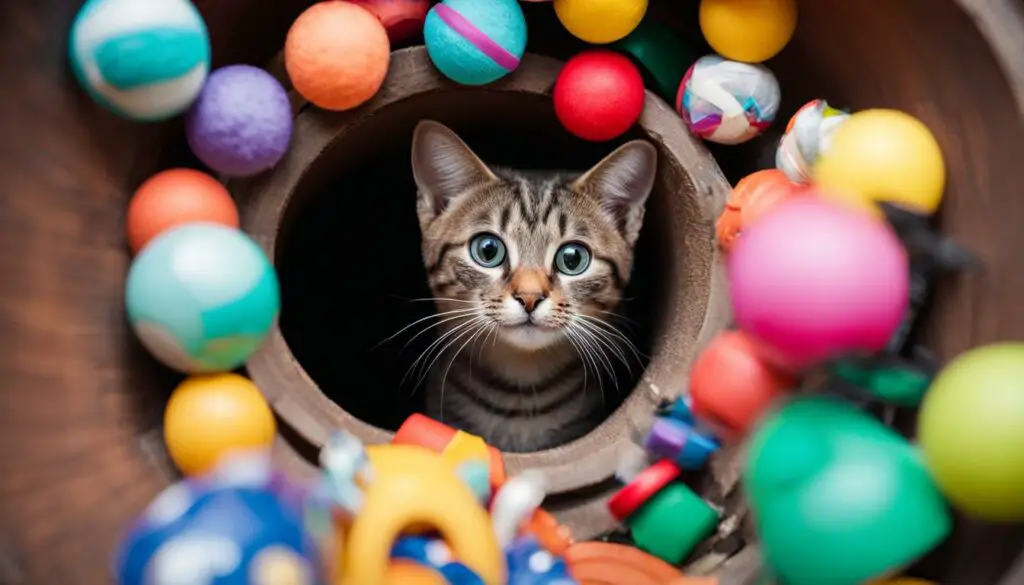
When choosing a cat tunnel, consider the size and materials. Opt for a tunnel that is large enough for your cat to comfortably move through and made from durable materials that can withstand scratching and rough play. Some cat tunnels even come with additional features like built-in crinkle noises or hanging toys to further engage your furry friend.
Benefits of Cat Tunnels:
- Provides mental stimulation
- Encourages exercise and physical activity
- Mimics natural hunting instincts
- Offers a safe and secure hiding place
I have a cat tunnel for my feline companion, and she absolutely loves it! She spends hours running through it, pouncing on her toys, and even napping inside. It’s great to see her having so much fun and getting the exercise she needs. I highly recommend cat tunnels for any cat owner looking to provide their furry friend with endless entertainment!
Disclaimer: Always supervise your cat while playing with a cat tunnel to ensure their safety and prevent any accidents or entrapment.
Making the Cat Carrier a Safe Space
When it comes to vet visits, many cats associate the cat carrier with stress and anxiety. However, with a few simple steps, you can transform the cat carrier into a safe space that your feline friend will actually enjoy. By creating a positive association with the carrier, you can help reduce your cat’s fear and make vet visits a more pleasant experience for both of you.
To start, it’s important to keep the cat carrier out at all times, not just when you’re planning a trip to the vet. By making the carrier a permanent fixture in your home, your cat will become familiar with it and see it as a normal part of their environment. You can place a cozy blanket or bedding inside the carrier to make it more inviting. Cats are attracted to soft and comfortable surfaces, so this will help create a positive association.
During vet visits, the carrier can be lined with a familiar-smelling item, such as a piece of clothing that carries your scent. This can provide a sense of comfort and familiarity to your cat, helping them feel more secure during the journey. Additionally, you can place treats or toys inside the carrier to entice your cat to enter and explore. Positive reinforcement through rewards will help your cat associate the carrier with positive experiences and reduce their anxiety.
Remember, patience is key when it comes to helping your cat view the carrier as a safe space. It may take some time and gradual acclimation for your cat to feel completely comfortable. By consistently providing positive experiences associated with the carrier, you can help alleviate their anxiety and create a calm and secure space for them.
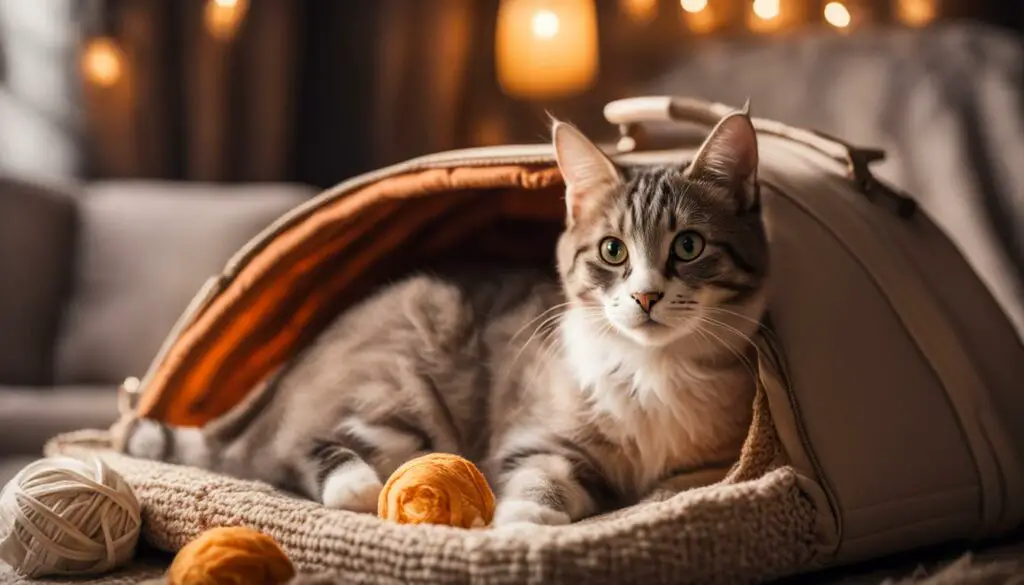
Table: Tips for Making the Cat Carrier a Safe Space
| Tips | Description |
|---|---|
| Keep the carrier out at all times | Make the carrier a permanent fixture in your home to familiarize your cat with it. |
| Add cozy bedding | Place a soft and comfortable blanket or bedding inside the carrier to make it more inviting. |
| Use familiar scents | Line the carrier with a familiar-smelling item, such as a piece of clothing, to provide comfort and familiarity. |
| Entice with treats and toys | Place treats or toys inside the carrier to encourage your cat to enter and associate it with positive experiences. |
| Be patient and consistent | It may take time for your cat to feel completely comfortable, so be patient and consistently provide positive experiences with the carrier. |
Household and DIY Options for Cat Hiding Spaces
Creating safe and comfortable hiding spaces for your beloved feline doesn’t have to break the bank. With a little creativity and some household items, you can provide your cat with their very own hidey hole. DIY options not only save you money, but they also allow you to customize the hiding spot to your cat’s preferences.
One popular DIY option is repurposing cardboard boxes. Cats are naturally drawn to boxes as they provide a cozy and enclosed space. Cut a small opening in the box and add a soft blanket or pillow inside. Your cat will have their own private retreat in no time.
Another household item you can use is shelves. Install a few shelves at different heights on your walls, creating a fun and elevated hiding spot for your cat. Add blankets or cushions to make it even cozier. Your cat will love lounging and observing their surroundings from their new hideout.
| Diy Options | Description |
|---|---|
| Cardboard boxes | Repurpose cardboard boxes into cozy hidey holes for your cat. |
| Shelves | Create elevated hiding spots by installing shelves on your walls. |
| Blankets and pillows | Add soft blankets and pillows to existing furniture or corners to create comfortable hiding spaces. |
If you’re feeling crafty, you can also try your hand at building a DIY cat tree. Use sturdy branches or wooden posts as the base and add platforms, perches, and enclosed hidey holes. Your cat will have their own play area and retreat all in one.
Remember, when creating DIY options, prioritize your cat’s safety. Ensure that any materials used are non-toxic and stable. Before introducing the new hiding space, give it a sniff test to make sure there are no strong odors that might deter your cat from using it.
Creating DIY hiding spaces for your cat not only provides them with a cozy retreat but also allows you to unleash your creativity. Explore your home, repurpose everyday items, and watch as your cat discovers their new favorite hidey hole.
Unsafe Hiding Places to Avoid
While providing your cat with hidey holes or hiding spots is important for their comfort and security, it is equally essential to be aware of unsafe places that can pose risks to their well-being. Cats are curious creatures that can sometimes find themselves in precarious situations. Avoiding these unsafe hiding places will help ensure your cat’s safety and prevent accidents. Here are some locations you should keep your cat away from:
Drawers
Drawers may seem like cozy hiding spots for cats, but they can be dangerous. Closing a drawer without realizing your cat is inside can lead to injuries or entrapment. Always double-check the contents of a drawer before closing it to prevent any accidents.
Washing Machine
While it may be tempting for a cat to climb into the washing machine for a quiet nap, this is an extremely hazardous place for them to hide. Always check inside the washing machine before starting a wash to ensure your cat is not inside. Consider keeping the laundry room off-limits to your cat or installing a childproof lock on the washing machine door.
Garage
The garage can be filled with potential dangers for cats, such as toxic chemicals, sharp tools, and vehicles. It’s important to keep the garage securely closed and prevent your cat from entering this area. If your cat accidentally gets into the garage, double-check before closing any doors or starting any machinery.
By being aware of these unsafe hiding places and taking the necessary precautions, you can create a safe environment for your cat to explore and relax without any unnecessary risks.
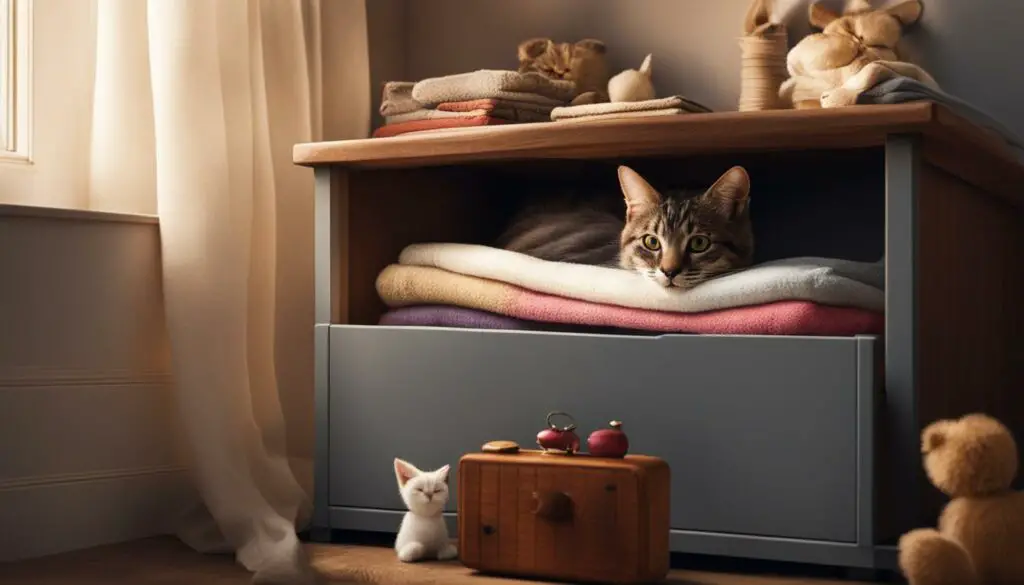
Creating Warm, Cozy, and Scented Hidey Holes
When it comes to providing the perfect hideaway for your feline friend, creating a warm, cozy, and scented hidey hole is essential. Cats are naturally drawn to warm and inviting spaces, so incorporating these elements into their hideout will make it even more enticing. By focusing on warmth, comfort, and scent, you can ensure that your cat’s hidey hole becomes their favorite spot in the house.
Warmth is Key
Cats love to curl up in cozy spots, especially when they want to relax or take a nap. Adding warmth to your cat’s hidey hole can be as simple as placing a soft blanket or cushion inside. Alternatively, you can use a heating pad specifically designed for pets, ensuring that it is set to a safe and comfortable temperature. The warmth will provide a comforting and soothing environment that will keep your cat coming back to their hidey hole time and time again.
Create a Cozy Haven
Coziness is an essential factor in creating the perfect hidey hole for your cat. Look for materials that are soft, plush, and comfortable, such as faux fur or fleece. Line the inside of the hideout with these cozy materials, creating a snug and inviting space for your cat to retreat to. Additionally, consider adding extra cushions or pillows to enhance the comfort level, allowing your cat to truly relax and feel at ease.
Scented Bliss
Cats have a highly developed sense of smell, and incorporating scent into their hidey hole can create an even more appealing space. One way to do this is by transferring your scent onto their bedding. Simply rub a piece of your clothing or a towel on yourself and then place it inside the hideout. This will provide a familiar and comforting scent that will help your cat feel safe and secure. Alternatively, you can use calming scents such as lavender or chamomile, which have been known to promote relaxation in cats.
By focusing on warmth, coziness, and scent, you can create the ultimate hideaway for your cat. Remember to choose materials that are cat-friendly, easy to clean, and safe. Whether it’s a plush cat bed with a heated pad or a DIY hideout made from blankets and pillows, your cat will appreciate having their own warm and cozy space to call their own.

Reasons Why Kittens Hide
Kittens are known for their curious and playful nature, but there are times when they choose to hide. Understanding the reasons behind their hiding behavior can help us provide a safe and supportive environment for our furry friends.
One common reason why kittens hide is their natural instinct to seek shelter from potential threats. As young and vulnerable animals, they are more cautious and wary of their surroundings. They may hide in small, enclosed spaces to feel secure and protected. This behavior is especially prevalent when they are introduced to new environments or when there are unfamiliar people or animals around.
Another reason why kittens hide is their need for privacy during napping. Like human babies, kittens require plenty of rest to support their growth and development. They may seek out quiet and secluded spots to take uninterrupted naps without disturbances. These hiding spots provide them with a sense of comfort and ensure that they can recharge and rejuvenate.
Kittens are also naturally curious creatures. They have a strong desire to explore their surroundings and learn about the world. This curiosity can sometimes lead them to hide in unexpected places as they venture into nooks and crannies. It’s important to create a safe and kitten-proof environment to prevent them from hiding in dangerous areas.
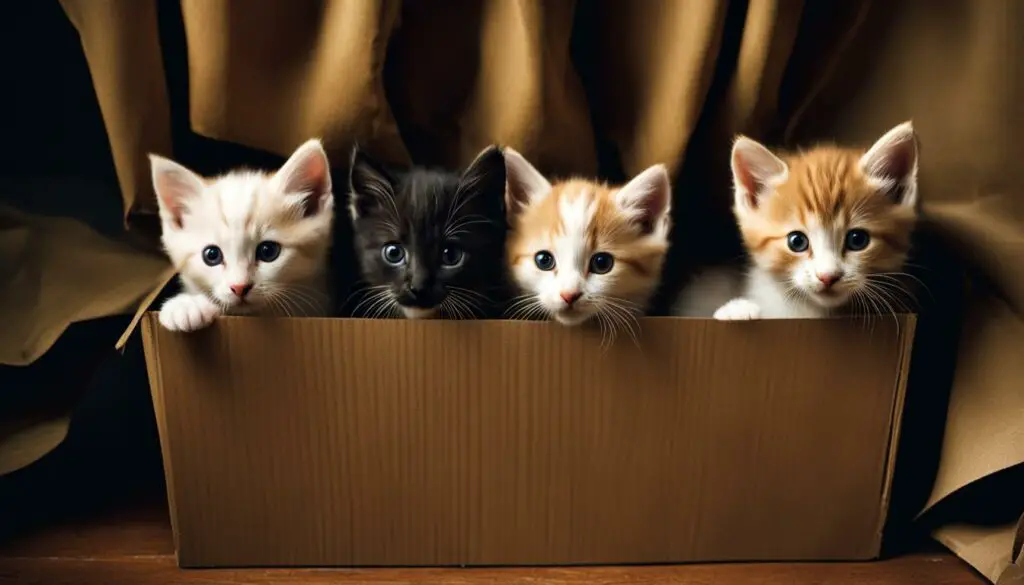
Kitten Hiding Behavior:
Table 11.1 provides an overview of common kitten hiding behaviors and their possible explanations:
| Hiding Behavior | Possible Explanation |
|---|---|
| Hiding in cardboard boxes | Seeking a cozy and enclosed space |
| Under furniture | Exploring and finding a secluded spot |
| Behind curtains or drapes | Curiosity and desire for a hidden vantage point |
| In small gaps or crevices | Natural instinct to seek shelter and feel safe |
By understanding the reasons behind kitten hiding behavior, we can ensure that they feel safe, secure, and comfortable in their environment. Providing them with appropriate hiding spots, such as cozy cat beds or designated hiding areas, can help satisfy their need for privacy and create a stress-free space for them to thrive in.
Popular Hiding Places for Kittens
When it comes to finding the perfect hiding spot, kittens are experts at discovering the most unexpected places. Whether it’s a cardboard box, a cupboard, or a cozy spot under the furniture, kittens are drawn to these hidden spaces for comfort and security.
Cardboard boxes are a classic favorite among kittens. Their small size and enclosed nature provide a sense of safety, making them an ideal hidey hole for a curious little feline. Kittens love to explore the ins and outs of a cardboard box, using it as a cozy retreat for napping or playing.
Cupboards are another popular hiding place for kittens. These closed spaces offer a sense of privacy and seclusion, allowing kittens to feel hidden from the outside world. It’s not uncommon to find a mischievous little furball tucked away in a cupboard, taking a break from their adventures.
Under furniture is a favorite spot for kittens to hide and observe their surroundings. The dark and sheltered space under the couch or bed provides a sense of security while still allowing kittens to keep an eye on what’s happening in the room. It’s a perfect spot for a kitten to feel safe while they nap or plan their next playful adventure.
| Hiding Places | Description |
|---|---|
| Cardboard Boxes | Small, enclosed spaces that provide comfort and security. |
| Cupboards | Closed spaces that offer privacy and seclusion. |
| Under Furniture | Dark and sheltered spaces where kittens can hide and observe. |
As a responsible pet owner, it’s important to create a safe environment for your kitten to explore and hide. Ensure that any potential hazards, such as sharp objects or toxic substances, are removed from their favorite hiding places. Additionally, keep an eye on your kitten when they are hiding to make sure they don’t get stuck or trapped in any tight spaces.
Understanding and respecting your kitten’s need for hiding spots is crucial for their well-being. These hiding places provide them with a safe space to retreat to when they are feeling overwhelmed or need some alone time. So, embrace their love for cozy nooks and crannies, and let them enjoy their favorite hidey holes!
Encouraging Kittens to Come Out of Hiding
When kittens are feeling scared or uncertain, they may retreat to hiding spots to seek comfort and security. As a pet owner, it’s important to create an environment that encourages them to come out of their hiding places and explore their surroundings.
One way to entice kittens out of hiding is by using food as a motivator. Place their favorite treats or a small amount of their regular food near their hiding spot. The enticing aroma and the promise of a tasty reward can help them overcome their initial fear and curiosity.
In addition to food, interactive toys can also be effective in encouraging kittens to come out of their hiding spots. Dangling a toy or using a wand toy to simulate prey can pique their interest and entice them to chase and play. Creating a playful and engaging environment can help kittens build confidence and feel more comfortable venturing out of their hiding places.
Remember, it’s important to be patient and allow kittens to come out of hiding at their own pace. Forcing them out or scaring them further may only reinforce their fear and make them more reluctant to explore. By providing tempting food and engaging toys, you can create a positive and encouraging environment that will help kittens feel more comfortable and secure.
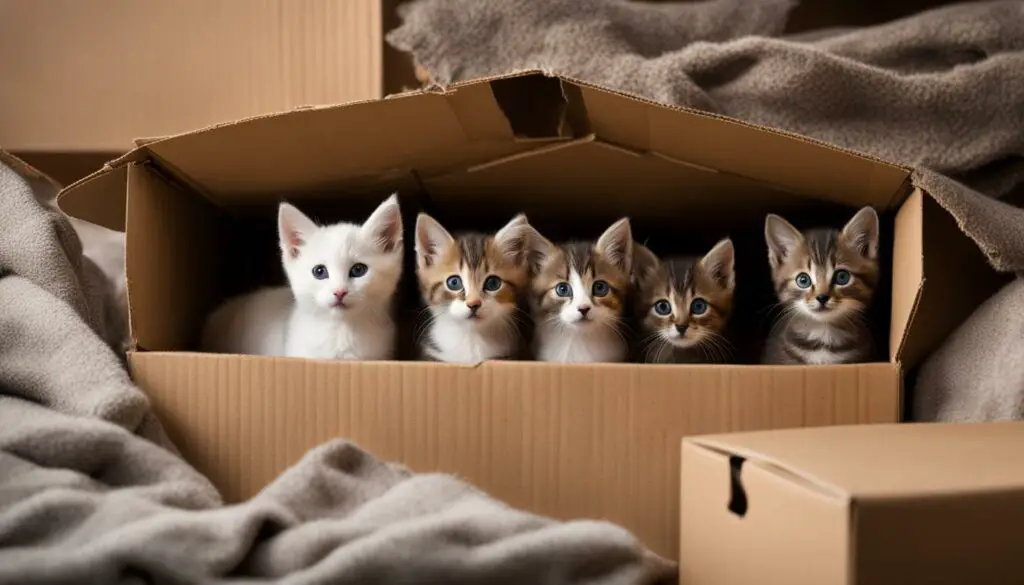
Tips for encouraging kittens to come out of hiding:
- Place their favorite treats or food near their hiding spot to entice them.
- Use interactive toys to engage and play with them.
- Provide a calm and quiet environment to reduce stress.
- Be patient and allow them to come out at their own pace.
- Avoid forcing them out or scaring them further.
Recognizing Potential Health Concerns
When it comes to our feline friends, it’s important to be vigilant and attentive to any signs of health concerns. Extended hiding behavior in cats can often be an indication that something is amiss. If your cat is consistently spending long periods in their hidey hole and avoiding interaction, it may be time to investigate further.
Illness is a common reason for extended hiding behavior in cats. Cats are masters at concealing any signs of illness or discomfort, and hiding is their way of coping with their symptoms. If your cat is hiding for an extended period and showing other concerning symptoms such as loss of appetite, lethargy, or changes in litter box habits, it’s crucial to consult a veterinarian for a thorough examination.
“Cats are experts at hiding signs of illness, so it’s important to pay attention to their behavior and look out for any changes that could indicate a health problem.”
Additionally, cats may hide when they are in pain. They instinctively retreat to a quiet and safe space to minimize any external stimuli that could exacerbate their discomfort. If your cat is hiding and displaying signs of pain such as limping, difficulty jumping, or vocalizing when touched, seeking veterinary attention is crucial to identify the source of their discomfort and provide appropriate treatment.
| Signs of Potential Health Concerns | What to Do |
|---|---|
| Extended hiding behavior | Monitor and observe for any changes or concerns |
| Loss of appetite | Consult a veterinarian for a thorough examination |
| Lethargy or decreased activity | Seek veterinary attention to determine the underlying cause |
| Changes in litter box habits | Consult a veterinarian for a comprehensive evaluation |
| Pain-related behaviors | Seek veterinary care to diagnose and treat any underlying issues |
Ensuring the health and well-being of our cats is our utmost responsibility as pet owners. By recognizing potential health concerns and taking prompt action, we can provide the necessary care and support for our beloved feline companions.
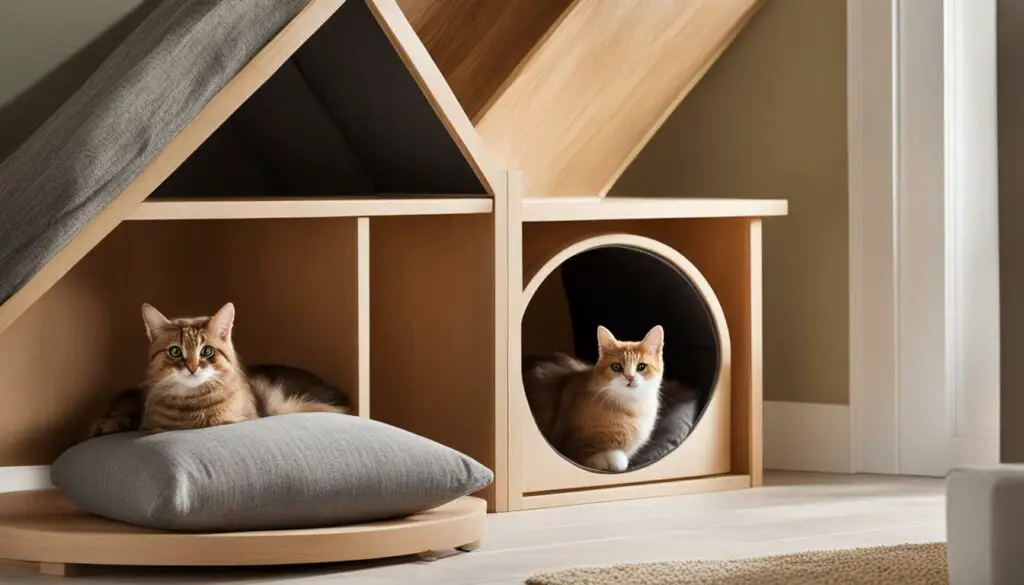
Avoiding Dangerous Hiding Places
When creating hidey holes for your cats, it’s important to be aware of potential dangers that certain hiding places can pose. Here are some areas to avoid:
- Furniture: Avoid allowing your cats to hide inside recliner chairs, sofas with reclining footrests, or other furniture that can cause injury if the mechanism is activated while the cat is inside.
- Appliances: Keep your cats away from appliances such as washing machines, dryers, dishwashers, and refrigerators. Cats may crawl inside these appliances, and if they are accidentally turned on, it can result in serious injury or suffocation.
- Garage: Cats should not be allowed to hide in the garage, especially when there are vehicles present. Always check for hiding cats before starting your car or moving any heavy equipment.
By being mindful of these potential hazards, you can help keep your cats safe and prevent accidents from occurring.
To visually illustrate the importance of avoiding these dangerous hiding places, take a look at the table below:
| Hazardous Hiding Place | Risks |
|---|---|
| Furniture | Possible injury if mechanism is activated |
| Appliances | Potential for injury or suffocation |
| Garage | Risk of injury from vehicles and heavy equipment |
Table: Risks of Hazardous Hiding Places for Cats
Conclusion
In conclusion, creating safe hidey holes for cats and kittens is of utmost importance. These cozy and secure hiding spots not only provide a sense of comfort but also help reduce stress levels in our feline friends. By understanding the significance of safe spaces and catering to their natural hiding behavior, we can ensure the overall well-being of our beloved pets.
Whether it’s a cat tree, a cat bed, or a DIY cardboard box hideout, offering a variety of options allows our cats to choose their preferred hidey hole. Kittens especially benefit from these spaces as they explore new environments and navigate the world around them. It’s important to recognize their hiding behavior and provide encouragement rather than forcing them out of their safe spots.
While safe hiding places are essential, it’s equally important to be aware of potential health concerns. Extended hiding or a sudden change in behavior can indicate illness, and seeking medical advice is crucial in ensuring the well-being of our furry companions. Additionally, we should avoid dangerous hiding spots like furniture, appliances, or garages to prevent any accidents or injuries.
In summary, safe spaces, such as cat hidey holes, play a vital role in the lives of our cats and kittens. Understanding their importance, recognizing their hiding behavior, and providing suitable options can enhance their overall comfort and happiness. By prioritizing their well-being, we can create a loving and secure environment for our feline friends.
FAQ
Why do cats need safe spaces?
Cats need safe spaces to feel secure and reduce stress. These spaces provide them with a sense of comfort and security in their environment.
What are some examples of cat hidey holes?
Cat trees, cat beds, cat caves, cat hammocks, cat tunnels, and even repurposed household items can all serve as cozy hiding spots for cats.
Why is it important to provide each cat with its own safe space in a multi-cat home?
Cats in multi-cat homes need their own independent safe spaces to avoid confrontations and have a place to retreat when feeling overwhelmed or anxious.
What are the benefits of cat trees as hiding spots for cats?
Cat trees not only provide hiding spots, but they also offer cats the opportunity to climb, scratch, and observe their surroundings from a higher vantage point.
How can I encourage my kitten to come out of hiding?
Using food, treats, or their favorite toys can entice a hiding kitten to come out. However, it’s important to be patient and avoid forcefully removing them from their hiding spot.
When should I seek medical advice if my kitten is hiding?
If your kitten is not coming out of hiding or missing meals for an extended period, it could be a sign of illness. It’s important to consult a veterinarian to ensure their well-being.
What are some unsafe hiding places for cats?
Drawers, washing machines, and garages can pose risks to cats if they hide in these spaces. It’s crucial to make these areas inaccessible to prevent accidents.
How can I make cat hidey holes more inviting?
Providing warm and cozy hiding spots, such as using blankets or heating pads, can make them more inviting to cats. Transferring your scent onto their bedding can also provide a sense of comfort and familiarity.
Why do kittens hide?
Kittens hide for various reasons, including their natural instinct to hide from potential threats, the need for privacy during naps, and their curiosity to explore new environments.
Where do kittens commonly hide?
Kittens have a knack for finding hiding places, including cardboard boxes, cupboards, and under furniture. These spaces provide them with a sense of security and a cozy spot for napping.
What should I do if my kitten is not coming out of hiding?
If your kitten is not coming out of hiding, it’s important to give them space and time. Using food, treats, or toys can help encourage them, but forcing them out is not recommended.
How can I ensure the safety of my kitten in hiding?
Some hiding places, such as inside furniture or appliances, can be dangerous for kittens. It’s important to be aware of these potential hazards and take measures to make them inaccessible.
Why are safe hidey holes important for cats and kittens?
Safe hidey holes provide cats and kittens with comfort, security, and a place to retreat when they are feeling overwhelmed or anxious. It helps reduce their stress levels and ensures their overall well-being.

